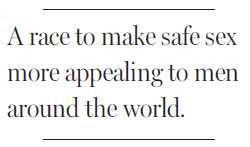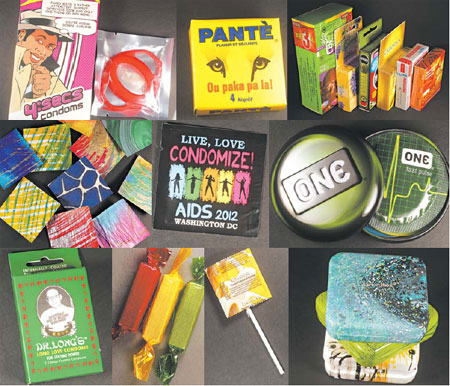The challenge of making condoms desirable
Updated: 2013-07-07 08:33
By Pam Belluck(The New York Times)
|
|||||||
|
Manufacturers have experimented with designs to make condoms more appealing. Photographs by Ozier Muhammad / The New York Times |

Most men do not like condoms.
And that's a public health obstacle and has led the Bill and Melinda Gates Foundation to collect applications for a grand challenge: to develop "a next-generation condom that significantly preserves or enhances pleasure."
The goal is to address unintended pregnancies and sexually transmitted diseases like AIDS. Condoms cheaply and effectively prevent both. But around the world only 5 percent of men wear them and there are 2.5 million new H.I.V. infections a year. Health experts want to double the number of condom users.
"Decreased sexual pleasure is typically the predominant reason for not using them," said Stephen Ward, a program officer for the Gates Foundation. "Can we actually make them more desirable?"
More than 500 applications poured in. The Gates contest will award winners $100,000 this fall, and up to $1 million later.
Condom experts - some of whom have studied the subject for years - have ideas of what might work and what won't.
"Guys would like it if they, first of all, don't believe they're wearing it," said Ron Frezieres, vice president of research and evaluation at the California Family Health Council, a longtime tester of condoms for industry, government and nonprofit organizations. "And second of all, it's got to be a little better than what they're used to."
In the developing world, condoms raise other issues. In some cultures, men are so resistant that women must engage in "condom negotiation." And women who carry condoms might be assumed to be prostitutes.
Bidia Deperthes, a senior H.I.V. technical adviser for the United Nations Population Fund, and Franck DeRose, executive director of the nonprofit Condom Project, use songs and dances about condoms to try to make them seem enjoyable, and give women ways to carry condoms discreetly, including containers that look like breath mint boxes.
Given the wide array of personal and cultural differences, the value of the Gates Foundation contest may be in finding several types of condoms - perhaps of new materials - and in helping them be produced inexpensively enough for the developing world.
Several manufacturers have worked on more appealing condoms. Some, like Pleasure Plus and Twisted Pleasure, designed by an Indian surgeon, Alla Venkata Krishna Reddy, whom one expert called the "Leonardo da Vinci of condoms," address complaints of tightness and friction. They are roomy, ballooning.
Another design, the eZ-On condom, was aimed at the "donning problem." Made of polyurethane, not latex, it was baggy, "gathered up inside what I call a tutu," Mr. Frezieres said. "It was not directional, so you could pull it down from either side."
One unsuccessful innovation was the Hat condom, resembling a little shower cap, designed, said Mr. Frezieres, "to fit just over the tip" to "provide maximum sensation." Alas, "in clinical testing, couples experienced difficulty keeping the Hat condom from popping off," he said.
Another idea was the spray-on condom, using liquid latex to create a condom shaped for the man using it. "Great concept," Mr. Frezieres said. But it did not have a tip to collect fluid, and "we were like, how do you get it off afterward?"
One promising design, already available in some parts of the world, is the Pronto 4:Secs condom, its box decorated with racy Dick Tracyesque cartoons. 4:Secs, its name both a pun and the time it is supposed to take to put on, is a condom in a plastic applicator resembling a life preserver. "This is really cool," said Ms. Deperthes, demonstrating how the applicator splits apart to allow the condom to be put on right-side up.
The Gates Foundation contest also welcomed designs for female condoms, but these have historically been even less popular.
They are much more expensive and need to be positioned correctly to avoid being pushed in or shifted to one side.
Amy and Max H., condom testers who live in Los Angeles and have been together for eight years, were unanimous in their antipathy to the female condom. As Max put it: "We both found the female condom to be aggressively unsexy. It didn't really seem to make much difference in terms of feeling, but visually we were like, 'Oh, man, we should just stop.' "
Perhaps the most innovative new American-made product is the Origami condom, still in clinical trials. Its inventor, Danny Resnic, said he was motivated by his own experience when "a latex condom broke and I wound up with an H.I.V. diagnosis."
Years of experimenting led him to devise a condom with accordionlike pleats, loose to allow movement inside. Made of silicone, which is meant to feel more like skin, it "goes on in less than a second," he said, and "there's no wrong way to put it on."
The New York Times
(China Daily 07/07/2013 page11)
